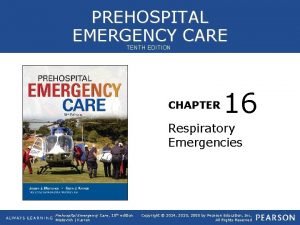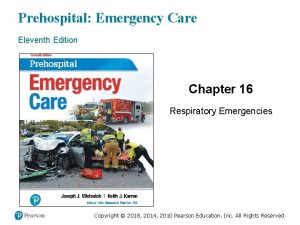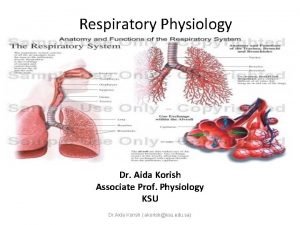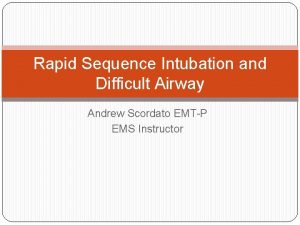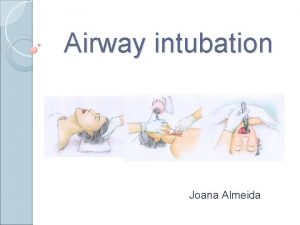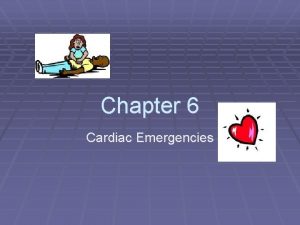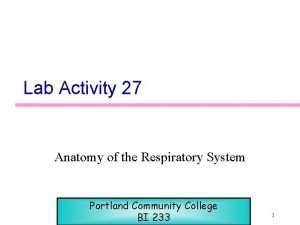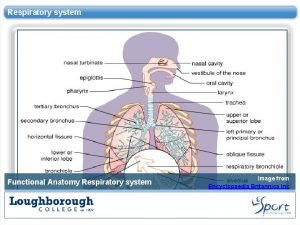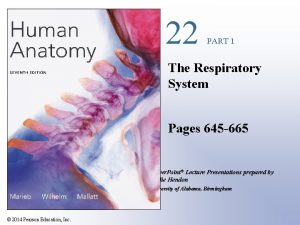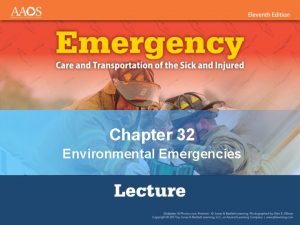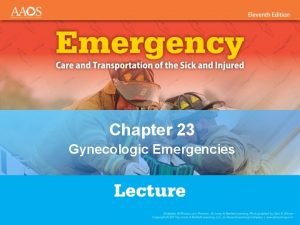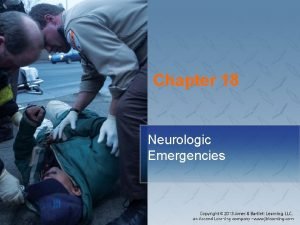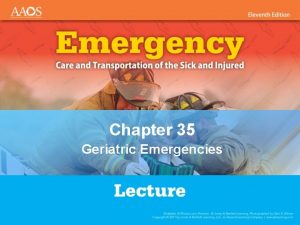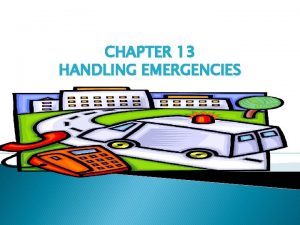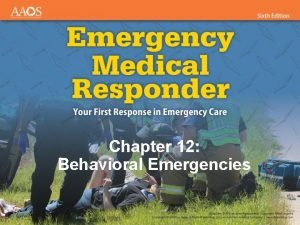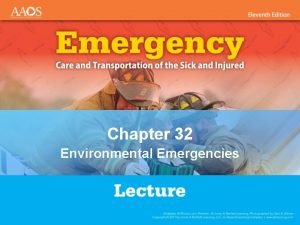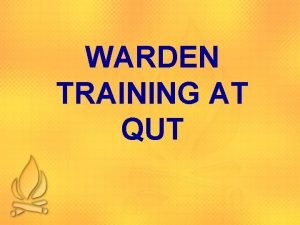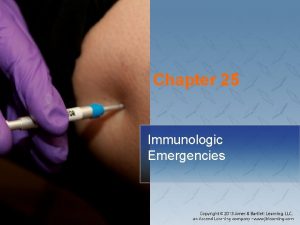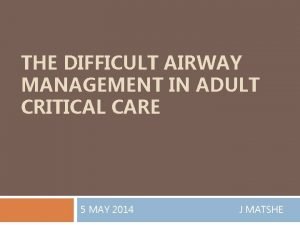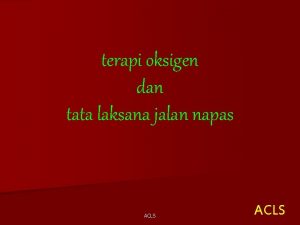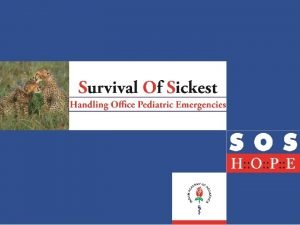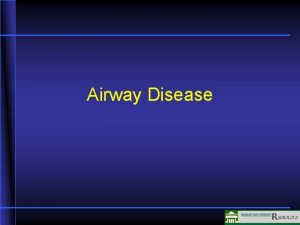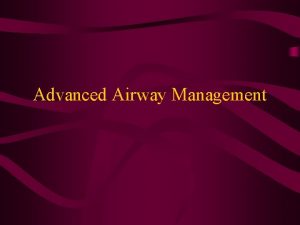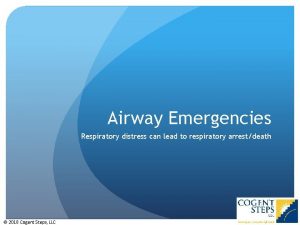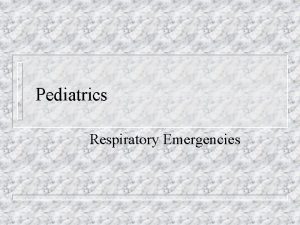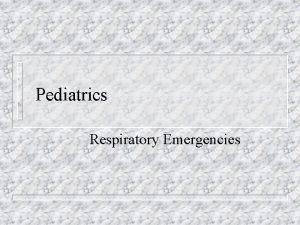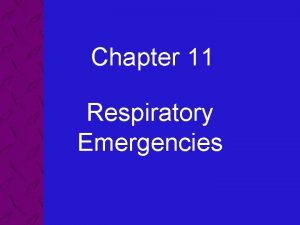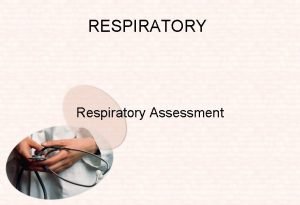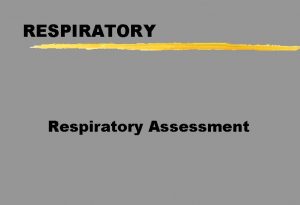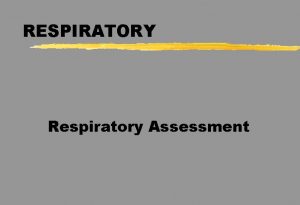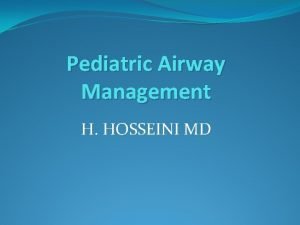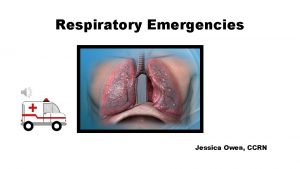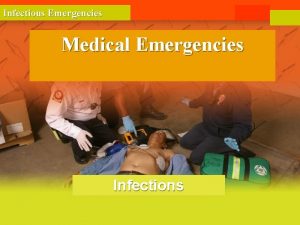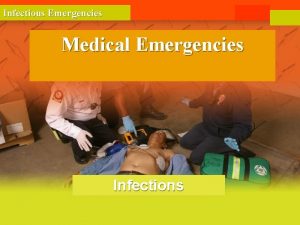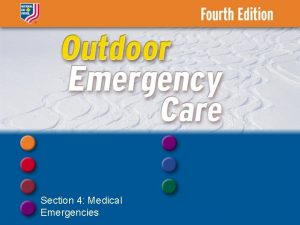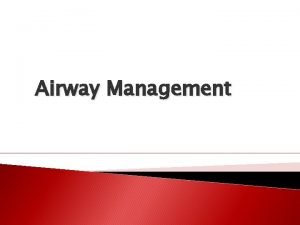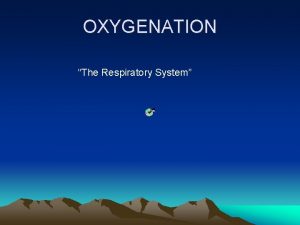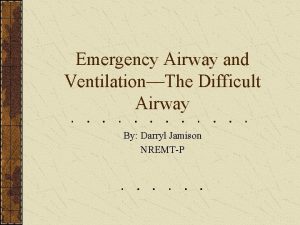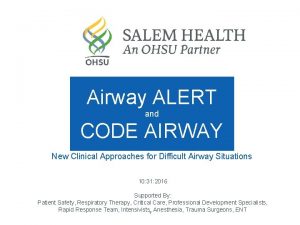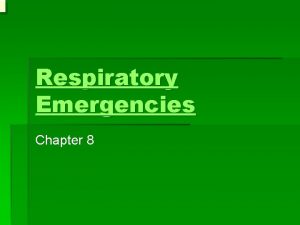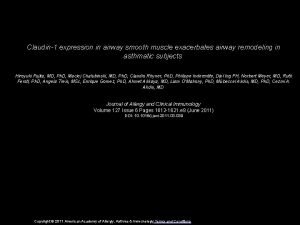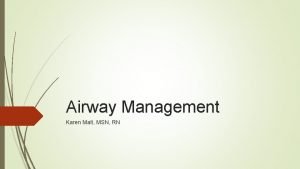Airway and Respiratory Emergencies Anatomy of the Respiratory








































- Slides: 40

Airway and Respiratory Emergencies

Anatomy of the Respiratory System

Anatomy of the Upper Airway Nasopharynx – Formed by the union of facial bones – Warms and humidifies air as it enters the body

Anatomy of the Upper Airway

Anatomy of the Upper Airway

Ventilation, Oxygenation, and Respiration

Inspiration Exhalation

Respiration • External respiration (pulmonary respiration) – Breathes fresh air into respiratory system – Exchanges oxygen and carbon dioxide between alveoli and blood in pulmonary capillaries

Respiration • Internal respiration – Exchange of oxygen and carbon dioxide between systemic circulatory system and cells

Respiration

Regulation of Ventilation • Pulmonary Ventilation is simply the movement of air into and out of the lungs. • Body is a constantly changing environment • Chemoreceptors monitor bodies CO 2 levels and adjust respirations to correct highs and lows. • Hypoxic drive is back-up system if normal system breaks down. (COPD)

Chief Complaint SOB • Common EMS Response • Initial Assessment – Appearance – LOC – ABCs

Signs of Adequate Breathing • Normal Rate 12 – 20 breaths/min • Regular pattern, with smooth flow of air • Clear and equal breath sounds bilaterally • Regular and equal chest rise and fall • Adequate depth (tidal Volume)

Signs of Inadequate Breathing • Labored breathing • Altered LOC • Respiratory rate less than 12 or greater than 20 with dyspnea • Irregular Rhythm (Cheyne Stokes, Kussmaul, Ataxic pattern) • Unequal chest expansion. • Shallow breathing • Skin Condition • Retractions

Factors Effecting Respiration • External factors – – Elevation Oxygen levels Toxic chemicals Confined Spaces • Internal Factors – – – Medical conditions Non functioning Alveoli Fluid in lungs Circulatory problems Metabolic problems

Foreign Body Obstruction • Partial – If able to talk or cough forcefully allow person to attempt to relieve on their own. – If poor air exchange and weak cough provide immediate intervention • Complete – Abdominal thrusts – If pulseless and apneic begin CPR. – Use tongue jaw lift and check back of oropharynx foreign body – No blind finger sweeps

Other Obstructions • Dental Appliances – If well fitting and in place leave in – If loose remove to prevent obstruction • Facial injuries – Blood may need to be suctioned – Broken teeth removed

Oxygen Delivery • Nasal Cannula – 1 - 6 lpm 24%-44% • Non Rebreather – 10 -15 lpm up to 90% • Bag Mask with reservoir – 15 lpm 100% • Mouth to Mask – 15 lpm 55%

Ventilation Rates • Adults – 1 breath every 5 - 6 seconds • Children and Infants – 1 breath every 3 - 5 seconds

CPAP • Mechanism – Increases pressure in the lungs – Opens collapsed alveoli – Pushes more oxygen across the alveolar membrane – Forces interstitial fluid back into the pulmonary circulation – Therapy is delivered through a face mask held to the head with a strapping system. – Use caution with patients with potentially low blood pressure.

CPAP • Indications – – – Awake & Alert Over 12 Patent airway GCS>10 BP above 90 systolic 2 of following • Retractions/Accessory muscle use • Respiratory rate >24 • Pulse Ox <92% • Inability to speak in complete sentences • Contraindications – – – – – GCS <11 Respiratory Arrest BP <90 Systolic Suspected Pneumothorax Tracheostomy Foreign body obstruction Facial deformity or trauma Actively vomiting Recent neuro, facial or gastric surgery – Chest head or face trauma

Airway Adjuncts • Oropharyngeal Airway • Nasopharyngeal Airway • BVM • Pocket Mask • Combi-tube • King Airway

Skills Practice

Respiratory Emergencies

Anatomy of the Respiratory System • Function of lungs is respiration. – Exchange of oxygen and carbon dioxide • Air travels through trachea into lungs, then on to: – Bronchi (larger airways) – Bronchioles (smaller airways) – Alveoli

Anatomy of the Respiratory System • Alveoli are microscopic air sacs. – Thin-walled – Actual exchange of oxygen and carbon dioxide occurs here.

Physiology of Respiration

Physiology of Respiration

Upper and Lower Airway Infection

Acute Pulmonary Edema • Heart muscle can’t circulate blood properly. • Fluid builds up within alveoli and in lung tissue. – Referred to as pulmonary edema – Usually result of congestive heart failure – Common cause of hospital admission

Chronic Obstructive Pulmonary Disease (COPD) • Slow process of dilation and disruption of airways and alveoli • Caused by chronic bronchial obstruction • Fourth leading cause of death • Tobacco smoke can create chronic bronchitis.

Chronic Obstructive Pulmonary Disease (COPD) • Emphysema is another type of COPD. – Loss of elastic material around air spaces – Causes include inflamed airways, smoking. • Most patients with COPD have elements of both chronic bronchitis and emphysema.

Asthma • Asthma is acute spasm of smaller air passages (bronchioles).

Spontaneous Pneumothorax • Pneumothorax is accumulation of air in pleural space. • Most often caused by trauma • Vacuum-like pressure in pleural space is lost. • When caused by medical conditions, is called “spontaneous. ”

Spontaneous Pneumothorax

Pulmonary Embolism • Passage of blood clot formed in vein into pulmonary artery – Circulation cut off partially or completely – Becomes lodged – Significantly decreases blood flow – If large enough, can cause sudden death

Pulmonary Embolism Cont. • Signs and symptoms include: – Dyspnea – Acute chest pain – Hemoptysis (coughing up blood) – Cyanosis – Tachypnea – Hypoxia

Other Respiratory Emergencies • Croup – Inflammation and swelling of pharynx, larynx, and trachea – Easily passed between children – Responds well to humidified oxygen • Epiglottitis – Bacterial infection causing swelling of flap over larynx – Position comfortably and provide oxygen.

Other Respiratory Emergencies • Pneumonia – Worldwide leading cause of death in children – Often a secondary infection – Will come on quickly and result in high fever. – Obtain a core temperature and treat with airway, ventilatory, and circulatory support.

Discuss Case Scenarios and Treatment Options
 Epiglottic
Epiglottic Chapter 16 respiratory emergencies
Chapter 16 respiratory emergencies Chapter 16 respiratory emergencies
Chapter 16 respiratory emergencies Respiratory airway secretary
Respiratory airway secretary Upper respiratory diagram
Upper respiratory diagram Soap me intubation
Soap me intubation Anesthesia hose
Anesthesia hose Endotracheal tube
Endotracheal tube Pulmonary arterioles
Pulmonary arterioles Human respiratory system diagram
Human respiratory system diagram Lesson 6: cardiac emergencies and using an aed
Lesson 6: cardiac emergencies and using an aed Chapter 19 endocrine and hematologic emergencies
Chapter 19 endocrine and hematologic emergencies Emt chapter 18 gastrointestinal and urologic emergencies
Emt chapter 18 gastrointestinal and urologic emergencies Chapter 28 first aid and emergencies
Chapter 28 first aid and emergencies Respiratory zone vs conducting zone
Respiratory zone vs conducting zone Anatomy of the upper respiratory tract
Anatomy of the upper respiratory tract Minute respiratory volume
Minute respiratory volume Functional anatomy of the respiratory system
Functional anatomy of the respiratory system External nose
External nose Local area orientation dive
Local area orientation dive Major nutritional deficiency diseases in emergencies
Major nutritional deficiency diseases in emergencies Environmental emergencies emt
Environmental emergencies emt Chapter 23 gynecologic emergencies
Chapter 23 gynecologic emergencies A behavioral crisis is most accurately defined as
A behavioral crisis is most accurately defined as Chapter 18 neurologic emergencies
Chapter 18 neurologic emergencies Lsu hematology oncology
Lsu hematology oncology Chapter 35 geriatric emergencies
Chapter 35 geriatric emergencies Chapter 13 handling emergencies
Chapter 13 handling emergencies Chapter 12 behavioral emergencies
Chapter 12 behavioral emergencies Chapter 32 environmental emergencies
Chapter 32 environmental emergencies Chapter 16 cardiovascular emergencies
Chapter 16 cardiovascular emergencies Psychiatric emergency
Psychiatric emergency Qut security contact number for emergencies
Qut security contact number for emergencies Immunologic emergencies
Immunologic emergencies Chapter 17 neurologic emergencies
Chapter 17 neurologic emergencies Stop maid intubation
Stop maid intubation Indikasi intubasi
Indikasi intubasi Alveoli in lungs
Alveoli in lungs Modified mallampati score
Modified mallampati score Statics persiapan intubasi
Statics persiapan intubasi Mean airway pressure formula
Mean airway pressure formula

